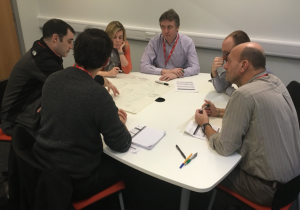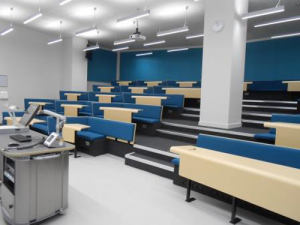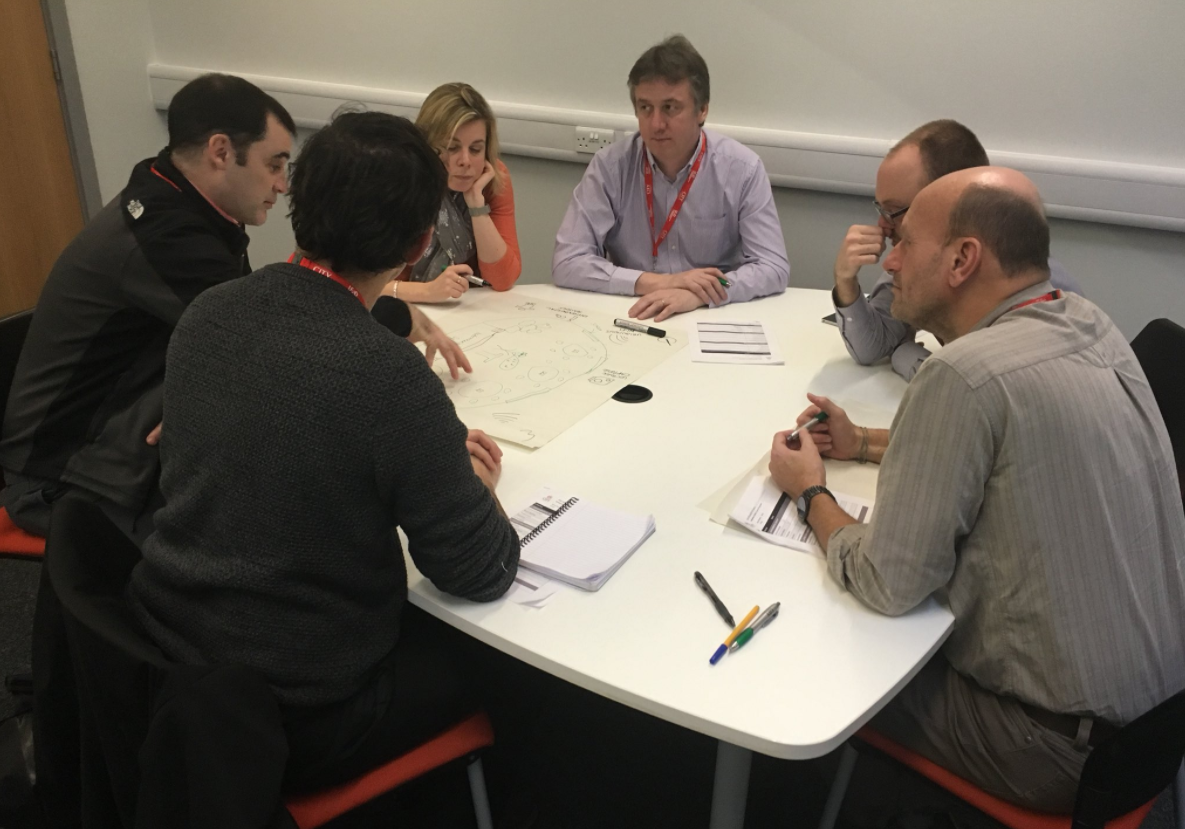
Let me first start by introducing myself.
I have recently completed my degree in Civil Engineering with Architecture and joined the LEaD team as a winter intern at City, supervised by Julie Voce, Head of Educational Technology and I met Sheila Egan who is the Learning Spaces Lead, part of the Educational Technology Team at City, University of London.
Having spoken to Sheila, I expressed my newfound interest in learning spaces as someone with a glimpse into architectural spaces on an external front and was consequently invited to the Association for Learning Technology Learning Spaces event on the 10th January 2018.
On the day, I attended the event and met several professionals from a variety of universities and organisations that had far more knowledge in pedagogy and learning spaces than I did. It was terrifying at first as I initially felt very much out of place, however I soon engaged in a conversation with someone from UCL and got invested in discussing the variety of learning spaces at UCL and then sharing my insight of the learning spaces I was exposed to as a former student of City. It was an icebreaker and I soon relaxed into this new environment.
INTRO
During the introduction that was presented by Sheila and Julie, I noticed that 3 out of the 4 rooms displayed on the presentation, which were developed by DALI, were lecture spaces I used as a student. It was easy to relate and agree to some extents at the benefits of using those rooms using the perspective I had on the space as a former student.
One of the rooms that I could relate to was ELG01 as seen below:

WORKSHOP 1
The first workshop took place in ELG02 and it was hosted by Dom Pates and James Rutherford from the LEaD Educational Technology Team. They immediately got the group engaged with an activity where we used our various devices to participate in a poll where different suggestions as to ‘what affects teaching and learning in a learning space’ were put forward and then voted upon. The suggestions that had the most votes were:
- Expectations created by the space (20 votes)
- Temperature & Light comfort (16 votes)
- The size of the class (9 votes)
My group’s discussion was mainly focused around the size of the room; the larger the room, the less likely students are to speak out and engage with the lecturer in the space. Of course, there were also contributions towards comfort in terms of temperature and light within the discussion. I felt like I was a stranger looking into the discussion, as I could relate what they talked about, but also as a recent former student, I also felt they were missing something vital. I shared with the group that I thought it was more to do with familiarity of a learning space which contributes to active engagement with the lecturer. For example, a student is more likely to speak out regardless of the size, temperature and light of the room, if he/she feels familiar with the space created. This could potentially be a matter of time or a matter of having been exposed to similar features within that learning space at an earlier time. At this point, the group was focused on me and appreciated that I had a different view, coming from a student background. It was interesting for me to see that. It made me realise in some ways, that the professionals that took part in the workshop were all from different departments that dealt with learning spaces. Some universities had professionals with an IT background looking at learning spaces, which would cause difference in views, therefore having some professionals looking more at the technical features of what a learning room needs to provide for the student and lecturer’s needs. Hearing the different views was interesting, and the need to balance technical capabilities against the teaching and learning requirements of those using the space is an important consideration in planning a learning space.
The suggestion with the most votes (‘Expectations created by the space’) was something I could directly agree with, as different rooms made me aware of what kind of lecture I would be in when I was a student.
I was introduced to the Reggio Emilia Approach as part of the presentation, following the interactive exercise. The Reggio Emilia is an educational philosophy that struck me to be quite inspiring when thinking about a learning space. Although it is typically focused on primary education, the fundamental principles could inspire higher education as well as private spaces.
The main principles that interested me in the Reggio Emilia Approach are:
- Learning progress is influenced by the student’s interest
- Teachers and Parents are co-learners
- The classroom environment is the “Third teacher”
(If you want to know more about the Reggio Emilia Approach, this link provides a good insight to the approach: Guide to Reggio Emilia Approach)


The second activity in this work shop was to judge two rooms; ELG02 and ELG12 in the teacher’s and student’s perspectives. We were split into two teams and assigned to different rooms where we were split again into two smaller teams to represent the teacher and the student. I had to think about the room and how it would satisfy the learning and teaching experience from a teacher’s perspective first. It was something I never really thought about so it took me a moment to adjust to this new point of view. I realised that although both rooms gave the teacher plenty of room to move around from, the setup in where he/she could place their equipment or use the computers from were immovable, rendering most of the movement to one specific spot. However, when discussing with my group about that, health and safety was at the forefront of the topic as making the pod movable would require a lot of cabling to be exposed and thus pose a risk.
When Dom asked us to then change to the other perspective, I felt like I was in my element. I immediately picked out things to do with the comfort of a student and the table surface area. ELG02 was laid out in a lecture theatre style and the table was barely enough to support a vertical A4 notepad. As you can see below from the picture, ELG02 had varying rows of seats; one with the chairs that could be spun around and one with seats quite close together. Those sitting at the packed seats, would have little space to use on the table if one sat next to them and those that used the swivel seats would have to reach far to use the excess table surface area offered. However, the swivel seats worked nicely in the group session, as you could fully turn around and face the row behind you to have discussions. I also could note that due to health and safety and space requirements, the seats were far from the table surface, therefore students wanting to use the table would have to lean forward and not be able to use the backrest of the seat. However, this could vary between how tall the person using it may be. Others noted things such as lighting and positioning as well.
WORKSHOP 2
We then moved onto the last task in ELG12, which was on ‘Deconstructing the classroom’. We were told to think about the necessities that a classroom needed to function and draw a plan view of the classroom. My group focused on Seating, Lighting, Sound and Technology.
We were then told to pick just one as the most important thing for the classroom; this made for a heated debate. A few of the group, especially those with an IT background thought that the most important thing in the classroom was Technology. Technology such as a computer and a screen to display the learning content as well as staying relevant with modern teaching ways.
Some thought of comfort such as seating to provide those that are learning with comfort and thus be able to focus effectively on learning.
It was quite tricky, but ultimately we agreed that we just needed students. Students that want to learn, will strive to learn no matter what kind of environment they are exposed to.
This may make some of you question whether there is any point of deconstructing a classroom; to be specific a learning space, when the answer we reached is just students.
However, without students, how can you begin to think about the learning space needed?
A learning space should focus on its audience; the students and the teacher. It should provide the best possible way for students to enhance their learning experience and for teachers to use their full potential in teaching.
Ultimately the exercise was an eye opener to most that participated and made us re-evaluate what is really important when thinking about learning spaces. I would personally recommend the exercise to anyone who is interested in learning spaces.
Overall, the event helped me gain a better understanding of the importance in decisions when creating a learning space and also gave me an insight to those that make the decisions on our learning spaces as a past student. It is great to see that many from a range of universities attended and came together to learn and understand more about learning spaces.


Thanks for writing this up! As you say in the beginning, it is very useful to have a student perspective on these issues as we often get blinkered into a certain way of thinking.
I am glad that my perspective can be useful. The event was a great insight for me too and I thoroughly enjoyed it. I learned a lot throughout the day.
thanks Shaminy, I missed the event so good to hear all about it for your blog post.
I am glad that you enjoyed reading about it through my post.